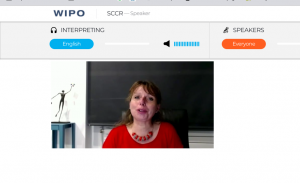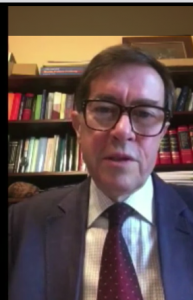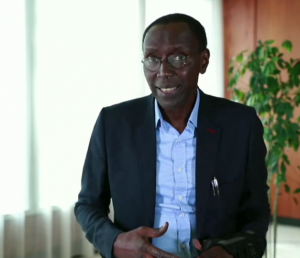The Angelus was sold by Millet for 1,000 francs in 1865, but just 14 years after Millet’s death in 1889, it was sold by the copper merchant Secrétan for 553,000 francs.

In France, 100 years ago, the resale right was established by the law of May 20, 1920.
It is in the Berne Convention for the Protection of Literary and Artistic Works
Article 14ter
“Droit de suite” in Works of Art and Manuscripts:
1. Right to an interest in resales; 2. Applicable law; 3. Procedure
(1) The author, or after his death the persons or institutions authorized by national legislation, shall, with respect to original works of art and original manuscripts of writers and composers, enjoy the inalienable right to an interest in any sale of the work subsequent to the first transfer by the author of the work.
(2) The protection provided by the preceding paragraph may be claimed in a country of the Union only if legislation in the country to which the author belongs so permits, and to the extent permitted by the country where this protection is claimed.
(3) The procedure for collection and the amounts shall be matters for determination by national legislation.
It is the law in over 65 countries but there is a need for clarification and harmonization. For the droit de suite to apply, the work, the sale and the artist must all qualify under the law. In general, the work must be an original work of art or a copy made in limited numbers by the artist himself or under his authority, including “works of graphic or plastic art such as pictures, collages, paintings, drawings, engravings, prints, lithographs, sculptures, tapestries, ceramics, glassware and photographs” In most cases, the sale must involve a professional party or intermediary, such as salesrooms, art galleries and, in general, any dealers in works of art. The droit de suite does not apply to sales directly between private individuals without the participation of an art market professional, nor to sales by individuals to public museums. The artist must be a national of a Member State or of another country which has droit de suite provisions: Member States are free, but not obliged, to treat artists domiciled on their territory as nationals.
At its 36th session, the SCCR Committee agreed to set up a task force of Members and stakeholders to report back to the Committee regarding the practical elements of the artists’ resale royalty right. At its 37th session, the Secretariat presented document SCCR/37/5, entitled Task Force on the Artist’s Resale Royalty Right, which was noted by the Committee. At its 38th and 39th sessions, the Secretariat presented updates on the ongoing work of the Task Force on the Artist’s Resale Royalty Right.
The initial proposal from Senegal and Congo was to include the resale right in the agenda of the future work of the Standing Committee. Three working groups were set up and they headed up, respectively by Madame Marianne Farifal, Professor Sam Richardson, and the now Chair of the SCCR Monsieur Abdoul Aziz Dieng.
The summary of each working group was presented in 3 short videos.
Marianne Farifel, Chair of Working Group 1 on galleries

Good day, I am Marianne Farifel, the Director General of the Society of Authors of Graphic and Plastic Arts and I’m Chair of the Working Group on Galleries and this Working Group seeks to present a panoramic overview of the application of the resale right to art galleries in different countries. We didn’t want to get bogged down in theoretical debates; rather, we’re focusing on specific issues which crop up with regard to the application of the resale right to galleries.
The Working Group was borne of the observation that it seems clear enough that the resale right applies to auction houses, but more issues arise with regard to the need to apply this right to art galleries in Member States. Indeed, art galleries are sometimes in a precarious situation, they play a key role in disseminating artists’ work and this is why they’re sometimes reluctant to apply what they perceive as an economic and admin burden.
In order to move beyond the stage of merely actual reflections and to move beyond simple negative feelings not underpinned with any concrete evidence, this Working Group seeks to take an objective view of the matter by gathering verified information and start from the ground with regard to the application of the resale right to the gallery sector in order to ensure that the discussions take place on this as soon as possible.
The data in the report comes from public reports developed by various entities, in particular by economists, but also by art pricing companies. We’ve also includes responses to the questionnaire which we sent out May 2020. A number of CMOs responded to us, and the report consists of three parts. The first part is to establish the number of galleries within national art markets, and in particular the number of galleries operating on the second market, indeed, it is key to recall that the resale right does not apply to galleries on the first primary market. The second part of the report seeks to identify the admin charge for art galleries when it comes to applying the resale right.
Finally, the third part of the report looks at the difficulties in applying the resale right to galleries due to professional frequency and due to the nontransparency of sales.Turning now to the number of galleries by the resale right. The report indicates that only 5% of galleries in Germany are affected, and 10 to 12% of galleries in Belgium and Netherlands, and 25% of the galleries in Austria and in France.
Now, as for the admin charge, as you can see in the report, depending on the size of the gallery, this varies between one hour and one day per year for galleries.
Now, as for applying the resale right to galleries, the foundation of professional art dealers is a pivotal point, as I said, which many of our respondents flagged and this topic is also relevant to galleries and like auction houses, because by the very definition auction houses are public and their results are not kept secret, so it’s easy to apply the resale right.
Business frequency is a major point for the activity of gallery, therefore, it’s a matter of knowing what bounds we have to strike between professional frequency and transparency in order to apply the right of resale.
National realities of markets differ, nevertheless, many respondents said that there is a need to have a more transparent market with rules respected by all, and this is a sign of a healthy and strong market. This will help us to in turn stem the scurge as everyone pointed out of fake artist goods on the art market.
We received responses to our questionnaire and three guidelines emerge from our work as we go forward. The first is to expand the questionnaire to respondents outside of Europe, but also to complement the report on certain points, such as the disparity, for example, in the burden of the resale right depending on legislations, which can be a source of double payment or an absence of payment.
Nevertheless, this disparity needs to be studied in greater detail in order to assess its real impact.Another avenue to explore is the establishment of Women and Intellectual Properties on the effective application of the right, in particular with regard to transparency, traceability, and the momentum of the art market involving rights management professionals and also artists, of course.
Finally, the establishment of documentation on the resale right applied to galleries with regular updating of studies would be a useful tool for the interested Member States.
Second video with Professor Sam Ricketson, Chair of Working Group 2 on jurisdictions

My name is Sam Ricketson and convenor of subworking group 2 of the artist resale right task force and we’ve been asked to look at management of art resale rights in different jurisdictions to identify what one might call the concrete modalities of these schemes, the principle features, and to provide a report that sets them out and contrasts and compares them.
Thus far we have considered responses from selected jurisdictions, namely the UK, France, Hungary, Australia, Czech Republic, Slovakia, Poland, Sweden, Russia, Brazil, and Uruguay. Not covered in our work so far have been issues arising with respect to the implementation and management of art resale rights and royalty schemes in developing countries, and although it should be noted that there are such schemes legislated for in a number of African countries, notably Senegal and Mali. We began our work early in the year with the circulation of a questionnaire to representatives of selected jurisdictions with the exception of Poland which did not have a relevant collecting society for artistic works.
And I’ll just run briefly through the questions that we put to our respondents, so as to give you some idea of the issues that we were trying to iron out from our respondents.
First of all, we asked when was art resale royalty right established in our country and how is this done? Was it done by inclusion within your national copyright law or was it done under some free-standing regulation or indeed in some other way?
Then we asked what works are subject to the scheme? For example, are there limitations on the kinds of artistic works covered? Does it extend beyond artistic works to original manuscripts of musical and literature books as is possible under Article 14.2 of the Berne Convention. And then what resales are covered, what resales are affected, and what exclusions are there to the resales subject to the royalty in your jurisdiction?
Then, most importantly, what is the royalty charge? How much is it? How is this done? Are there minimum amounts before it can be charged? Are there maximum ceilings or ceilings beyond which the royalty is not applied? Whose liable to pay? Is it the buyer, the seller, or perhaps an intermediary? How is the scheme managed? For example, is it left simpliy as a matter to individual artists to pursue and enforce themselves, or is it subject to some form of collective management in how it’s done? What are the levels of returns to artists? Are there any particular groups that benefit more than others? Do all the artists benefit, perhaps, more than younger artists, and what about deceased estates? What administrative issues arise in managing the royalty right in your jurisdiction? In particular, what are the costs involved, and to what extent has it been possible, particularly where collective management applies to deploy digital technologies in tracking down and dealing with these rights?
Then we asked about reciprocal arrangements between different countries which have these rights, particularly as between collecting societies. And if there are such arrangements, how have they been put into effect? And what are the other issues that arise with respect to the implementation and operation of art resale royalty right schemes in your country? Are there strong constituencies of support for these rights, or are there areas of opposition and what is it?
Finally, what changes, if any, have been proposed to the scheme that you have?
The results thus far show a variety of practices that have been adopted by the countries that we’ve thus far considered in implementing art resale royalty right schemes. There are variations, as one might expect, with respect to the kinds of work covered. Some jurisdictions exclude particular categories of artist works and others are more expansive.
The kinds of resales that are covered and the exclusions to those resales, these are important issues in which there are differences between a number of jurisdictions. There are differences as to the rights charged and whether there are maximum level it’s that are imposed. Broadly speaking, one is looking at a royalty right of somewhere between 3% to 5%, but there are particularly in European countries that are subject to the EC Directive, maximum levels beyond which the royalty is not charged.There are differences as to the persons responsible for payment, and when we come to mode of administration of the right, there are differences as to the mode of collective administration that’s adopted in most countries, whether it’s compulsory or voluntary, or whether the jurisdiction in question is simply as a matter to individual enforcement.

Monsieur Dieng, Chair of the SCCR and Chair of Working group 3 presented the resale right as a factor in the economic rebalancing between the North and the South.
It took the form of interviews with famous artists whose works are certainly successful, and I’m talking about African artists in particular. So, the various views expressed reflect their use, and these views in no way reflect the opinions of WIPO nor the opinions of the author of the study. So what’s the issue here at stake when it comes to the African market? Some people think that the resale rights are all very well in theory and principle, but there is no real market so we don’t see any point in it.
Artists respond with this. Some artists think that even if there is no market, so to speak, we need to take into account the fact that works travel a great deal and that the sales prices of works continues to rise, and all of theistic atal demonstrates this. The money that we receive in Africa helps us tremendously in our work and in our projects.
Some other artists say, well, no, no, we shouldn’t say that there is no market, that’s not right. There is an emerging market and we need to look at what is being developed and what is being born. There is also an emerging market which we can see the indexes for. We can see lots of new talent. We can see works that are traveling around more and more. We see the prices of works are increasing, the number of galleries is also increasing.
Artists who have been successful are setting up their own foundations to support new talent. This helps bring about the emergence of the market. The word “justice” crops up time and again. One famous artists actually talked about the journey of one of his recent works. It was sold for $16,000 Euros initially and it was then resold for $26,000 Euros in Europe, which allowed the artist to receive money from the resale right. The same work of art was sold yet again in the United States of America for $70,000 Euros, but in this instance he didn’t receive a penny. He says that it is a great source of frustration. This frustration is something that many African artists feel, and so much so that they develop a sense of animosity towards the countries of the north.
Certainly, it’s excessive, he says, but we can understand them, nevertheless. And so the resale right enables to establish some kind of justice and it helps the artist to be associated with the commercial success of his work, but also to have some kind of traceability on the journey his work takes.
In brief, I should say that all of the African artists are very much in favor of the resale right. For the continuation of our work, it would be interesting to create some kind of mapping of the art market, and by the same token, it will be also interesting to look at the emerging trends in Africa. Thank you.
The Chair gave the floor to the delegates. The Africa Group reaffirmed its support from Senegal and Congo for inclusion of artist royalty right as standing item on the agenda of the SCCR. Stating that there are more than 80 countries across the world that has incorporated the artist resale royalty right in their legislation, the group believes that this right is a moral and economic imperative for visual creators and provides equity.
The European Union which has issued a Directive (2001/84/EC of the European Parliament and of the Council of 27 September 2001) on the resale right for the benefit of the author of an original work of art reiterates its support for discussion on this topic at the SCCR.
The US Delegation expressed its interest in the continuation of this discussion.
Malawi, Paraguay, Gabon, Kenya and Bostwana all took the floor in support of making the resale right a sustantive permanent item on the SCCR agenda. Colombia, which has the resale rights in its legislation would like some assistance regarding the implementation.
When the Chair gave the floor to NGOs, only IFFRO, CISAC and KEI were called on since time was of essence.
IFRO:
Thank you, Mr. Chair, IFRO is global network for the collective management authorization and as well as author and publishers in text and image sector. We are very grateful to the Member States that support the resale right, and we express our support for the proposal from Congo and Senegal to include the resale right in the Agenda of Future Work by the SCCR.
We believe SCCR is the right Forum for all of us to hear, learn, and discuss how creators can be better protected and remunerated through mechanisms such as the resale rights. Resale rights ensures artists receive fair renumeration when their art works are sold on the secondary art marketed, and is issue of fairness to artists whose works are traded in the globalized art market. IFRRO approved the resale right on the SCCR agenda since it was first raised. We strongly believe that the benefits of the resale right to visual artists deserves action at WIPO. Thank you, Mr. Chair.
CISAC:
Thank you, Mr. Chair. We would like to thank the Distinguished Delegates and experts for the comprehensive reports on the activity of the task force. In previous CISAC created a report to create a Forum of experts to discuss and report on the practical elements of the artist resale right.
Today, we are pleased to see that the work of the task force is progressing swiftly, addressing a number of topics that raise concern among some delegates at the later sessions of the Committee. We are confident that the outcomes of this exercise will bring added value to the discussions in the Committee and will shed more light on the different aspects of this issue.
Mr. Chair, this year we celebrate 100 years since the resale right was implemented for the first time, and that was in France in 1920, and the need for the right became clear when a collector made a significant amount of money from the sale of painting — while the family of the artist was living in extreme poverty. Since then, much progress has been made. The resale right has proven to be an important tool to foster creativity in visual arts and the implementation is increasing all across the world. More than 80 countries, including all EU Member States have resale rights legislation in place. In many other countries, possible implementation of the resale right is under discussion, but there is still a long way to go to ensure that all artists without discrimination receive a fair share in the economic success of their works, and indeed the absence of the right in countries representing major art markets, prevents visual artists worldwide from fully benefiting from the work, since recognition is required under international law.
This means that if the country where the art work is sold or the artist’s own country do not recognize the right, the artist will not benefit from the right. And for this reason, it is important to ensure the effective harmonization of the right and secure its availability around the world without discrimination and this will guarantee artists all around the world, including native artists, have a way of sharing in the wealth created by their art, without having to rely on trust or charity of art market middlemen.
We are confident that the findings of the task force will dispel the doubts raised by some of the delegates and will encourage Member States to start as soon as possible substantive discussions on the proposal of Senegal and Congo towards a meaningful outcome. Thank you, Mr. Chair.
KEI:
I thank you. KEI echos the U.S. comment on the Chair’s contribution to this agenda item. KEI supports the the proposal tabled by Senegal and Congo to include the artists’ resale right so long as the right is for physical works of art. Sam Ricketson study on this topic was particularly useful. KEI believes the artist resale right for physical works of art is an appropriate area for norm setting at the SCCR. The proposal benefits artists and provides a modest redistribution of income from the collectors and dealers to artists, particularly those artists who are at a point in their lives in a weak bargaining position as with regard to the prices they charged.
We also note that there is a strong cross-border trade in physical works of art. An work created in Africa, Asia, or Latin America may be sold in London, Paris, Hong Kong or New York for example. We are in support if the art is limited to physical works of art, paintings, sculptures and original manuscripts and you should note that KEI does not support a global norm on resale right in reproduction or copies of rights. If WIPO wants to have success here, it would be wise to be narrow and focused to physical works.
Sometimes WIPO seems more concerned about the corporate right owners than the artists themselves, but this is an example where WIPO can do something for artists and address a socially awkward outcome where artists do not benefit fairly from the commercialization of an article of art as its value becomes better understood. A UN Treaty on this topic, if limited to physical works of art, would be a beautiful thing. Thank you.